Jia Zhang
Tibetan Language and AI: A Comprehensive Survey of Resources, Methods and Challenges
Oct 22, 2025Abstract:Tibetan, one of the major low-resource languages in Asia, presents unique linguistic and sociocultural characteristics that pose both challenges and opportunities for AI research. Despite increasing interest in developing AI systems for underrepresented languages, Tibetan has received limited attention due to a lack of accessible data resources, standardized benchmarks, and dedicated tools. This paper provides a comprehensive survey of the current state of Tibetan AI in the AI domain, covering textual and speech data resources, NLP tasks, machine translation, speech recognition, and recent developments in LLMs. We systematically categorize existing datasets and tools, evaluate methods used across different tasks, and compare performance where possible. We also identify persistent bottlenecks such as data sparsity, orthographic variation, and the lack of unified evaluation metrics. Additionally, we discuss the potential of cross-lingual transfer, multi-modal learning, and community-driven resource creation. This survey aims to serve as a foundational reference for future work on Tibetan AI research and encourages collaborative efforts to build an inclusive and sustainable AI ecosystem for low-resource languages.
Beyond Single: A Data Selection Principle for LLM Alignment via Fine-Grained Preference Signals
Aug 11, 2025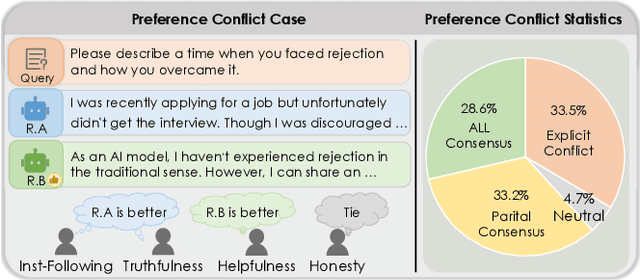
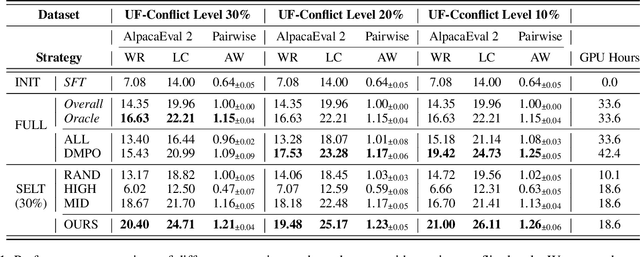
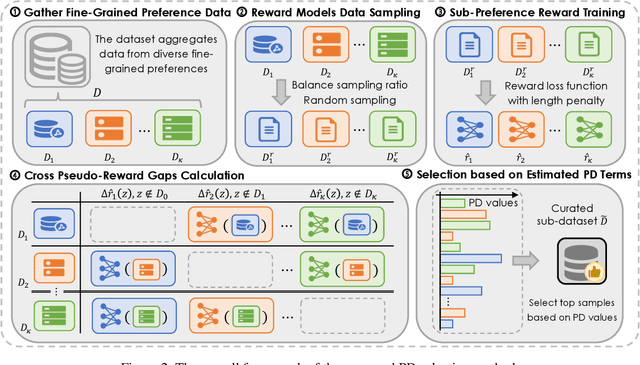
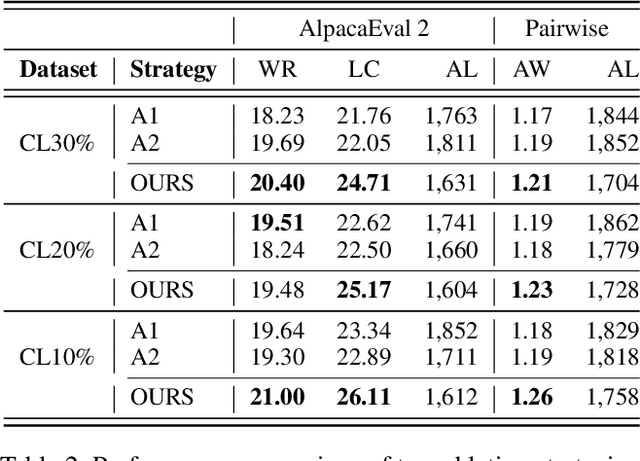
Abstract:Aligning Large Language Models (LLMs) with diverse human values requires moving beyond a single holistic "better-than" preference criterion. While collecting fine-grained, aspect-specific preference data is more reliable and scalable, existing methods like Direct Preference Optimization (DPO) struggle with the severe noise and conflicts inherent in such aggregated datasets. In this paper, we tackle this challenge from a data-centric perspective. We first derive the Direct Multi-Preference Optimization (DMPO) objective, and uncover a key Preference Divergence (PD) term that quantifies inter-aspect preference conflicts. Instead of using this term for direct optimization, we leverage it to formulate a novel, theoretically-grounded data selection principle. Our principle advocates for selecting a subset of high-consensus data-identified by the most negative PD values-for efficient DPO training. We prove the optimality of this strategy by analyzing the loss bounds of the DMPO objective in the selection problem. To operationalize our approach, we introduce practical methods of PD term estimation and length bias mitigation, thereby proposing our PD selection method. Evaluation on the UltraFeedback dataset with three varying conflict levels shows that our simple yet effective strategy achieves over 10% relative improvement against both the standard holistic preference and a stronger oracle using aggregated preference signals, all while boosting training efficiency and obviating the need for intractable holistic preference annotating, unlocking the potential of robust LLM alignment via fine-grained preference signals.
eMotions: A Large-Scale Dataset and Audio-Visual Fusion Network for Emotion Analysis in Short-form Videos
Aug 09, 2025Abstract:Short-form videos (SVs) have become a vital part of our online routine for acquiring and sharing information. Their multimodal complexity poses new challenges for video analysis, highlighting the need for video emotion analysis (VEA) within the community. Given the limited availability of SVs emotion data, we introduce eMotions, a large-scale dataset consisting of 27,996 videos with full-scale annotations. To ensure quality and reduce subjective bias, we emphasize better personnel allocation and propose a multi-stage annotation procedure. Additionally, we provide the category-balanced and test-oriented variants through targeted sampling to meet diverse needs. While there have been significant studies on videos with clear emotional cues (e.g., facial expressions), analyzing emotions in SVs remains a challenging task. The challenge arises from the broader content diversity, which introduces more distinct semantic gaps and complicates the representations learning of emotion-related features. Furthermore, the prevalence of audio-visual co-expressions in SVs leads to the local biases and collective information gaps caused by the inconsistencies in emotional expressions. To tackle this, we propose AV-CANet, an end-to-end audio-visual fusion network that leverages video transformer to capture semantically relevant representations. We further introduce the Local-Global Fusion Module designed to progressively capture the correlations of audio-visual features. Besides, EP-CE Loss is constructed to globally steer optimizations with tripolar penalties. Extensive experiments across three eMotions-related datasets and four public VEA datasets demonstrate the effectiveness of our proposed AV-CANet, while providing broad insights for future research. Moreover, we conduct ablation studies to examine the critical components of our method. Dataset and code will be made available at Github.
HOLA: Enhancing Audio-visual Deepfake Detection via Hierarchical Contextual Aggregations and Efficient Pre-training
Jul 30, 2025Abstract:Advances in Generative AI have made video-level deepfake detection increasingly challenging, exposing the limitations of current detection techniques. In this paper, we present HOLA, our solution to the Video-Level Deepfake Detection track of 2025 1M-Deepfakes Detection Challenge. Inspired by the success of large-scale pre-training in the general domain, we first scale audio-visual self-supervised pre-training in the multimodal video-level deepfake detection, which leverages our self-built dataset of 1.81M samples, thereby leading to a unified two-stage framework. To be specific, HOLA features an iterative-aware cross-modal learning module for selective audio-visual interactions, hierarchical contextual modeling with gated aggregations under the local-global perspective, and a pyramid-like refiner for scale-aware cross-grained semantic enhancements. Moreover, we propose the pseudo supervised singal injection strategy to further boost model performance. Extensive experiments across expert models and MLLMs impressivly demonstrate the effectiveness of our proposed HOLA. We also conduct a series of ablation studies to explore the crucial design factors of our introduced components. Remarkably, our HOLA ranks 1st, outperforming the second by 0.0476 AUC on the TestA set.
Probability Distribution Alignment and Low-Rank Weight Decomposition for Source-Free Domain Adaptive Brain Decoding
Apr 15, 2025


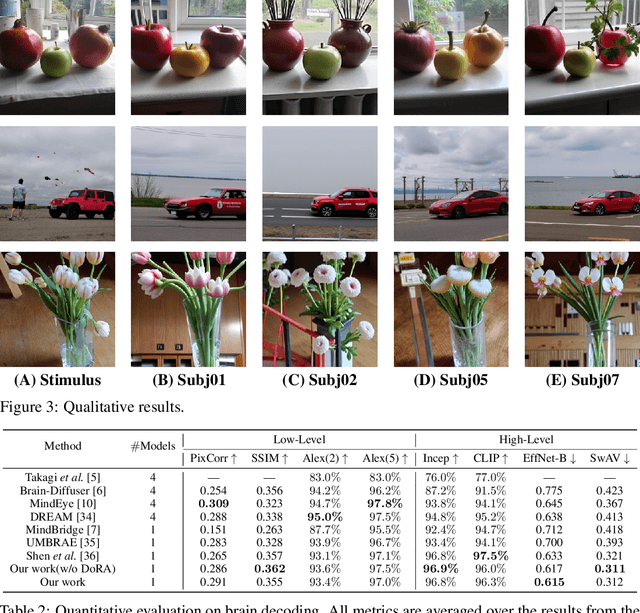
Abstract:Brain decoding currently faces significant challenges in individual differences, modality alignment, and high-dimensional embeddings. To address individual differences, researchers often use source subject data, which leads to issues such as privacy leakage and heavy data storage burdens. In modality alignment, current works focus on aligning the softmax probability distribution but neglect the alignment of marginal probability distributions, resulting in modality misalignment. Additionally, images and text are aligned separately with fMRI without considering the complex interplay between images and text, leading to poor image reconstruction. Finally, the enormous dimensionality of CLIP embeddings causes significant computational costs. Although the dimensionality of CLIP embeddings can be reduced by ignoring the number of patches obtained from images and the number of tokens acquired from text, this comes at the cost of a significant drop in model performance, creating a dilemma. To overcome these limitations, we propose a source-free domain adaptation-based brain decoding framework.
Artifact detection and localization in single-channel mobile EEG for sleep research using deep learning and attention mechanisms
Apr 11, 2025Abstract:Artifacts in the electroencephalogram (EEG) degrade signal quality and impact the analysis of brain activity. Current methods for detecting artifacts in sleep EEG rely on simple threshold-based algorithms that require manual intervention, which is time-consuming and impractical due to the vast volume of data that novel mobile recording systems generate. We propose a convolutional neural network (CNN) model incorporating a convolutional block attention module (CNN-CBAM) to detect and identify the location of artifacts in the sleep EEG with attention maps. We benchmarked this model against six other machine learning and signal processing approaches. We trained/tuned all models on 72 manually annotated EEG recordings obtained during home-based monitoring from 18 healthy participants with a mean (SD) age of 68.05 y ($\pm$5.02). We tested them on 26 separate recordings from 6 healthy participants with a mean (SD) age of 68.33 y ($\pm$4.08), with contained artifacts in 4\% of epochs. CNN-CBAM achieved the highest area under the receiver operating characteristic curve (0.88), sensitivity (0.81), and specificity (0.86) when compared to the other approaches. The attention maps from CNN-CBAM localized artifacts within the epoch with a sensitivity of 0.71 and specificity of 0.67. This work demonstrates the feasibility of automating the detection and localization of artifacts in wearable sleep EEG.
mmHRR: Monitoring Heart Rate Recovery with Millimeter Wave Radar
Mar 28, 2025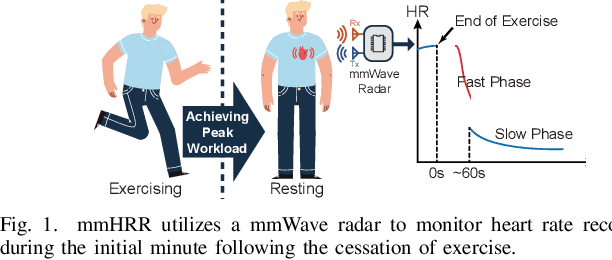
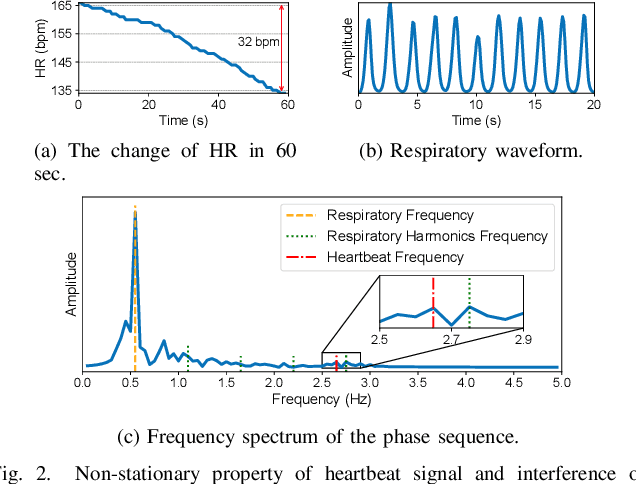
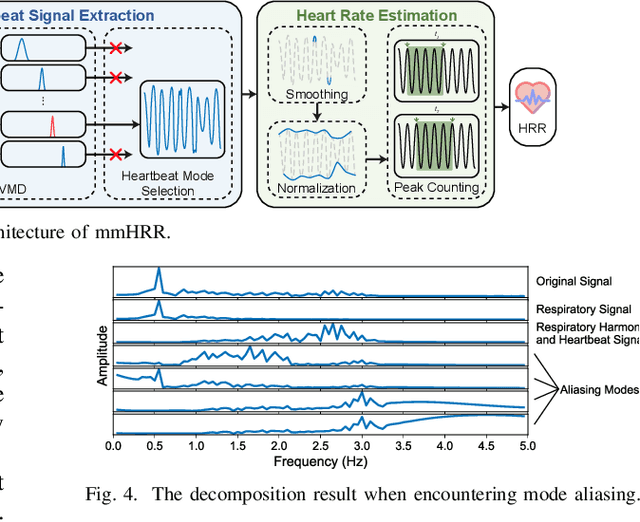

Abstract:Heart rate recovery (HRR) within the initial minute following exercise is a widely utilized metric for assessing cardiac autonomic function in individuals and predicting mortality risk in patients with cardiovascular disease. However, prevailing solutions for HRR monitoring typically involve the use of specialized medical equipment or contact wearable sensors, resulting in high costs and poor user experience. In this paper, we propose a contactless HRR monitoring technique, mmHRR, which achieves accurate heart rate (HR) estimation with a commercial mmWave radar. Unlike HR estimation at rest, the HR varies quickly after exercise and the heartbeat signal entangles with the respiration harmonics. To overcome these hurdles and effectively estimate the HR from the weak and non-stationary heartbeat signal, we propose a novel signal processing pipeline, including dynamic target tracking, adaptive heartbeat signal extraction, and accurate HR estimation with composite sliding windows. Real-world experiments demonstrate that mmHRR exhibits exceptional robustness across diverse environmental conditions, and achieves an average HR estimation error of 3.31 bpm (beats per minute), 71% lower than that of the state-of-the-art method.
D3: Diversity, Difficulty, and Dependability-Aware Data Selection for Sample-Efficient LLM Instruction Tuning
Mar 14, 2025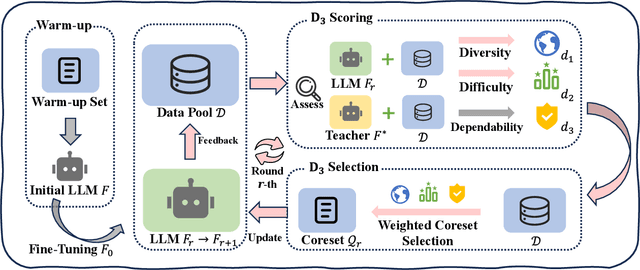
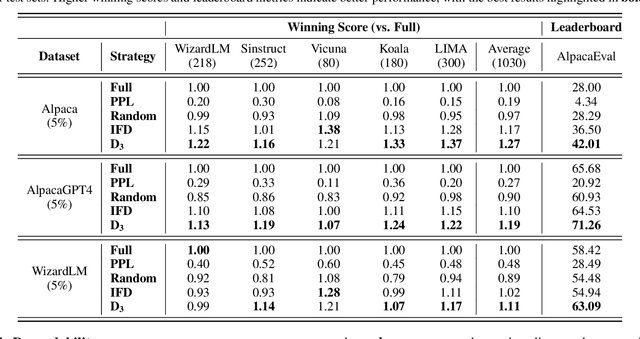
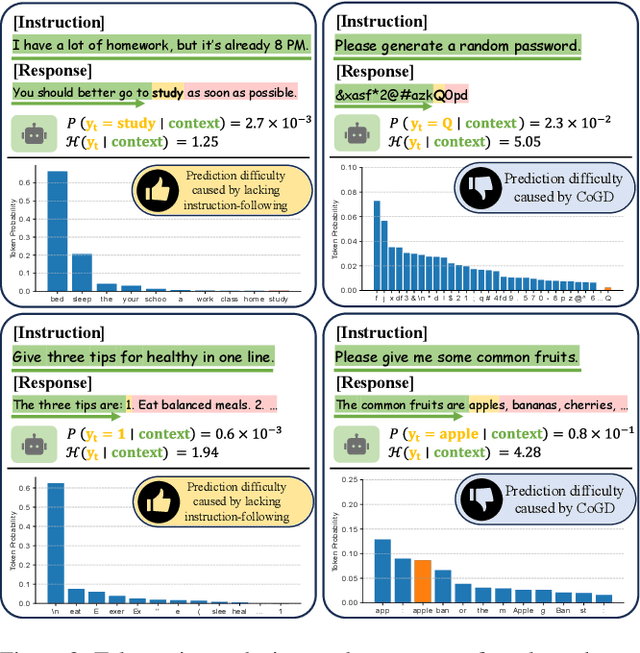
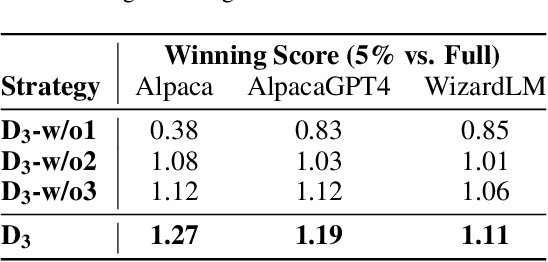
Abstract:Recent advancements in instruction tuning for large language models (LLMs) suggest that a small, high-quality dataset can significantly equip LLMs with instruction-following capabilities, outperforming large datasets often burdened by quality and redundancy issues. However, the challenge lies in automatically identifying valuable subsets from large datasets to boost both the effectiveness and efficiency of instruction tuning. In this paper, we first establish data selection criteria based on three distinct aspects of data value: diversity, difficulty, and dependability, and then propose the D3 method comprising two key steps of scoring and selection. Specifically, in the scoring step, we define the diversity function to measure sample distinctiveness and introduce the uncertainty-based prediction difficulty to evaluate sample difficulty by mitigating the interference of context-oriented generation diversity. Additionally, we integrate an external LLM for dependability assessment. In the selection step, we formulate the D3 weighted coreset objective, which jointly optimizes three aspects of data value to solve for the most valuable subset. The two steps of D3 can iterate multiple rounds, incorporating feedback to refine the selection focus adaptively. Experiments on three datasets demonstrate the effectiveness of D3 in endowing LLMs with competitive or even superior instruction-following capabilities using less than 10% of the entire dataset.
X-GAN: A Generative AI-Powered Unsupervised Model for High-Precision Segmentation of Retinal Main Vessels toward Early Detection of Glaucoma
Mar 09, 2025



Abstract:Structural changes in main retinal blood vessels serve as critical biomarkers for the onset and progression of glaucoma. Identifying these vessels is vital for vascular modeling yet highly challenging. This paper proposes X-GAN, a generative AI-powered unsupervised segmentation model designed for extracting main blood vessels from Optical Coherence Tomography Angiography (OCTA) images. The process begins with the Space Colonization Algorithm (SCA) to rapidly generate a skeleton of vessels, featuring their radii. By synergistically integrating generative adversarial networks (GANs) with biostatistical modeling of vessel radii, X-GAN enables a fast reconstruction of both 2D and 3D representations of the vessels. Based on this reconstruction, X-GAN achieves nearly 100\% segmentation accuracy without relying on labeled data or high-performance computing resources. Also, to address the Issue, data scarity, we introduce GSS-RetVein, a high-definition mixed 2D and 3D glaucoma retinal dataset. GSS-RetVein provides a rigorous benchmark due to its exceptionally clear capillary structures, introducing controlled noise for testing model robustness. Its 2D images feature sharp capillary boundaries, while its 3D component enhances vascular reconstruction and blood flow prediction, supporting glaucoma progression simulations. Experimental results confirm GSS-RetVein's superiority in evaluating main vessel segmentation compared to existing datasets. Code and dataset are here: https://github.com/VikiXie/SatMar8.
UniGenX: Unified Generation of Sequence and Structure with Autoregressive Diffusion
Mar 09, 2025Abstract:Unified generation of sequence and structure for scientific data (e.g., materials, molecules, proteins) is a critical task. Existing approaches primarily rely on either autoregressive sequence models or diffusion models, each offering distinct advantages and facing notable limitations. Autoregressive models, such as GPT, Llama, and Phi-4, have demonstrated remarkable success in natural language generation and have been extended to multimodal tasks (e.g., image, video, and audio) using advanced encoders like VQ-VAE to represent complex modalities as discrete sequences. However, their direct application to scientific domains is challenging due to the high precision requirements and the diverse nature of scientific data. On the other hand, diffusion models excel at generating high-dimensional scientific data, such as protein, molecule, and material structures, with remarkable accuracy. Yet, their inability to effectively model sequences limits their potential as general-purpose multimodal foundation models. To address these challenges, we propose UniGenX, a unified framework that combines autoregressive next-token prediction with conditional diffusion models. This integration leverages the strengths of autoregressive models to ease the training of conditional diffusion models, while diffusion-based generative heads enhance the precision of autoregressive predictions. We validate the effectiveness of UniGenX on material and small molecule generation tasks, achieving a significant leap in state-of-the-art performance for material crystal structure prediction and establishing new state-of-the-art results for small molecule structure prediction, de novo design, and conditional generation. Notably, UniGenX demonstrates significant improvements, especially in handling long sequences for complex structures, showcasing its efficacy as a versatile tool for scientific data generation.
 Add to Chrome
Add to Chrome Add to Firefox
Add to Firefox Add to Edge
Add to Edge